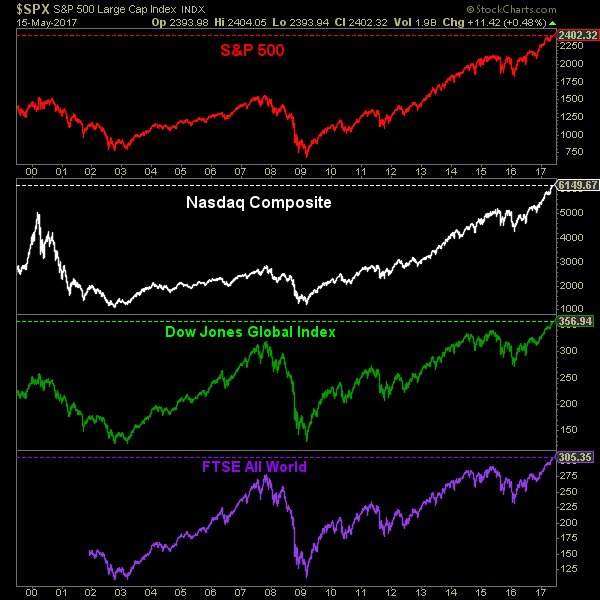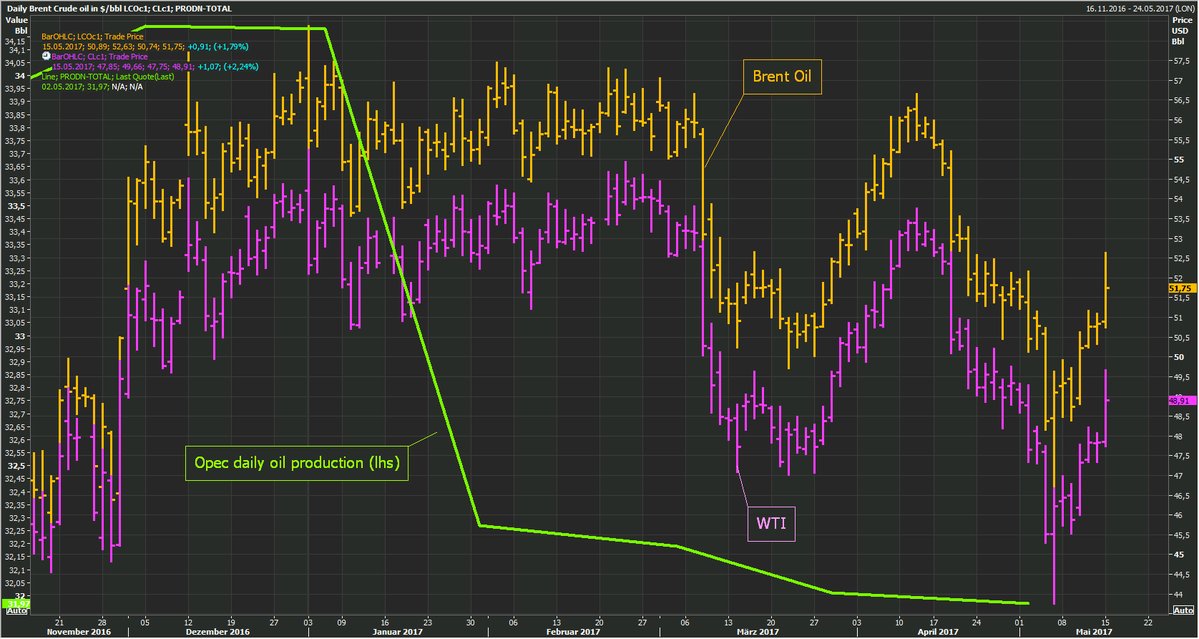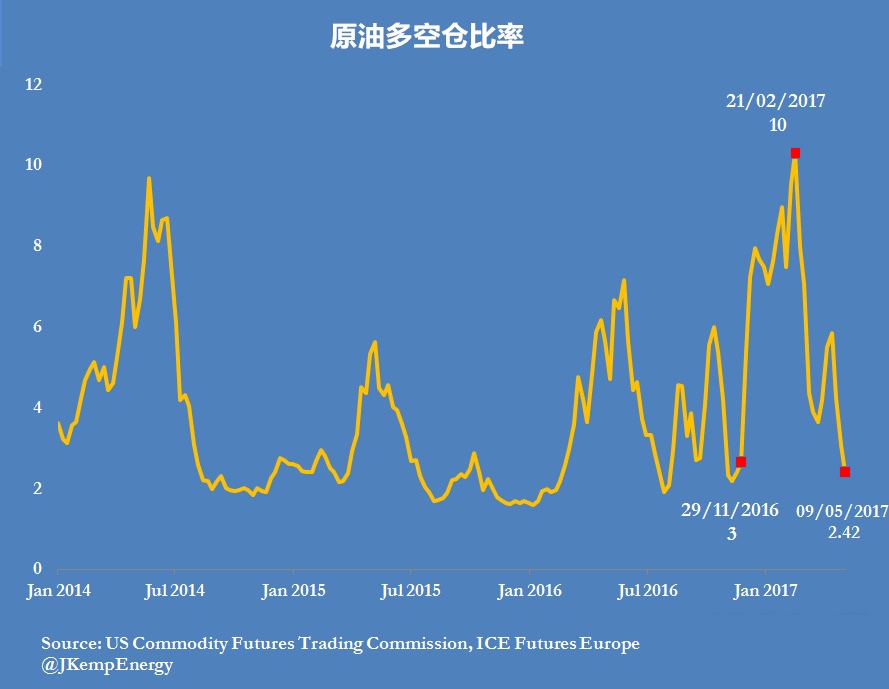Global Forex May 16th - The US dollar, which was boosted by the French election last week, seems to have been completely reinstated at the beginning of this week. The US dollar index weakened further after falling below the 200-day moving average on Monday and has now fallen below the 99 mark. Global Forex reported yesterday that although the US dollar index last week rose by about 0.6% last week and recorded a rise in the first week of the five weeks, the performance of the position data is obviously not optimistic. In the past week, the net long position of the US dollar has fallen to the lowest level since the beginning of October last year, and the net position of the euro has turned positive for the first time in three years. Subject to a new wave of unsatisfactory economic data and resource-sensitive currencies, the weak start of the dollar at the beginning of this week is undoubtedly not surprising.
It is worth mentioning that from the overall perspective of the global market, the most attractive class of assets in the financial market may be crude oil. Affected by the surge in oil prices on Monday, resource-sensitive currencies soared across the board in the overnight foreign exchange market, while the three major US stock indexes helped the market optimism and also closed the record high. At present, there are only less than 10 days left in the OPEC oil-producing countries meeting in the latter part of this month, and the agreement to extend production between oil-producing countries seems to be the general trend. At the time when the production reduction agreement was first reached in November last year, the soaring oil price led the market to rise in risky assets, and whether this same scene will be staged this time is undoubtedly worth watching.
The data is weak and magnifies the position of the "life gate"! The dollar bulls have been beaten back to the original shape?
The dollar fell on Monday, hitting a low against multiple currencies, after weak US manufacturing data, along with rising commodity prices, pulled the dollar down. In May, a New York State manufacturing activity survey unexpectedly fell, and the index turned negative for the first time since October. Analysts warned that the index's decline may be a sign that manufacturing may worsen. After the US CPI data fell short of expectations last Friday, the US dollar has fallen sharply for two consecutive trading days.
.jpg)
According to the latest data released by the United States, the New York Fed’s May manufacturing index was negative at 1.00, the first time it fell to a negative value in October. In February of this year, the index once hit the highest level since October 2014. This is the worst data since October 2016 and the first negative value as new order data has plummeted from a seven-year high to a seven-month low.
.jpg)
JPMorgan analyst Daniel Silver wrote in the research report, "We have been expecting a slowdown in manufacturing after the start of the year, but if the New York State Order Index is a reliable forward-looking indicator, then the manufacturing slowdown The degree may be more serious than we expected."
After the data was released, the euro rose to a one-week high of $1.0989 against the dollar, and the dollar hit a one-week low of 0.9958 Swiss francs against the Swiss franc. Eric Viloria, senior currency strategist at Wells Fargo Securities, said, “The data is weaker than expected, and the market’s original estimate is rising... this is a big reason for the dollar’s ​​decline.â€
Some analysts pointed out that overnight data has once again increased investors' concerns about the US economic outlook. The current US economic surprise index has fallen to a new low in the past year. With the weak performance of US macro data, the Fed’s interest rate hike prospects are beginning to be questioned. This week's news is relatively light, the US dollar focuses on economic data, especially industrial output, and of course, the speech of Fed officials, the focus will be on information on contraction.

The weak performance of US economic data is clearly also amplifying the "life gate" of the change in US dollar positions. Global Forex has introduced overnight, the net long position of the US dollar in the most recent week fell to the lowest level since the beginning of October - a total of 11 billion US dollars, lower than the previous week's 12.7 billion. Large speculators dominated by hedge funds closed 27,900 euro short contracts in the week, bringing the total short position to 133,200, which is half of the record high set in October last year. The short exit of the bears caused the euro futures net position (total longs minus total shorts) to turn positive for the first time in three years, to 22,400 contracts.

The latest HSBC research team wrote that the political risk in the euro zone is the beginning of the transformation of the foreign exchange market, and the dollar situation may become unfavorable. In addition, the HSBC research team said that the end of the French election will be a turning point for the euro, and instead the dollar will begin to face political risks. The market shift indicates that the dollar will go down, especially against the euro.
EUR/USD is currently approaching the 200-day moving average, meaning the euro is expected to rise to 1.10 or even exceed that level. But whether the euro/dollar can break through 1.10 depends largely on the demand for the dollar.
The soaring oil price is a "spoiler" in the market? Saudi Arabia and Russia have reached an agreement on extending production cuts!
At the same time as the dollar fell sharply overnight, another major change in the global market on Monday was that a series of risky assets represented by oil prices showed another significant increase. In the foreign exchange market, the Canadian dollar hit a two-week high, and the Australian dollar hit a 12-day high. As crude oil futures jumped, metal prices were boosted, and the currencies of economies linked to raw material exports rose.
At the same time, the US S&P 500 and the Nasdaq broke through the highs of May 10 respectively, both of which closed at a new high. The S&P 500 index closed for the first time at the 2,400-point integer mark. The stock index was mainly boosted by rising prices of energy, commodities and technology blue chips.

Eric Viloria, senior currency strategist at Wells Fargo Securities, pointed out: "In addition to US data, other reasons that affect exchange rate movements, at least today, are commodity prices, especially oil prices, because we see currencies with large exchange rate changes. Goods are more sensitive to the currency."
According to Reuters, the world's top two oil producers, Saudi Arabia and Russia, have reached a consensus on Monday that the oil production reduction agreement needs to be extended by nine months to March 2018 to alleviate the global crude oil supply surplus. The news boosted oil prices by up to 2% and led the European currency market. The timing of the decision was earlier than the next formal meeting of the Organization of Petroleum Exporting Countries (OPEC) on May 25, and the strong wording of the statement surprised the market, which would be very beneficial to ensure other OPEC members and participate in the first Other countries that have reduced production agreements are supported together.

After a brief talk with Russian Energy Minister Novak, Saudi Energy Minister Fahren said in a joint statement that the two sides agreed to extend the existing production reduction agreement for another nine months to March 2018. The two promised to “make every effort†to reduce global inventories to a five-year average water level, and they are also optimistic about the support of oil-producing countries outside the participating countries. “Inventories have decreased significantly, but we have not yet touched on the five-year average we hope to reach,†said Saudi Energy Minister Farah and Russian Energy Minister Novak at a joint press conference in Beijing. “We came to the conclusion that the production reduction agreement needs to be extended.â€
Based on the current agreement starting on January 1, OPEC and other oil-producing countries including Russia have promised to cut production by nearly 1.8 million barrels per day in the first half of this year. Saudi Arabia and Russia together control one-fifth of the global oil supply. Although it has been widely expected that OPEC and Russia will agree to extend the production reduction agreement, the timing and wording of this statement will drive oil prices to rise by more than 1.5% during Asian trading hours on Monday.
According to Virendra Chauhan, an analyst at Energy Aspects in Singapore, “I think OPEC and Russia realize that in order for the market to regain their side, they will need to adopt 'shocking' tactics, not simply to extend the agreement, the market will also focus on cutting Exporting, not just reducing production, is what is required to rebalance the market."
Major oil-producing countries have been forced to extend production cuts because of the situation, even though the market still maintains sufficient supply after the current production reduction agreement is reached, making crude oil futures hover around $50 a barrel. OPEC, a source familiar with the market, told Reuters on Monday that since the beginning of the year, the global oil storage of floating storage devices has been reduced by a third.
Interestingly, Reuters analysts noted that both the fluctuations in oil prices and the position of market participants, the performance of the oil market seems to be the same as before OPEC reached a production reduction agreement in November last year. Whether this scene will indicate that oil prices will lead the global market to repeat the changes in the market at the end of last year is undoubtedly attracting attention.
It is reported that oil prices have been rising since last Wednesday. On Monday, Russia and Saudi Arabia announced a one-month increase of 3% after a one-month extension. This scene is similar to the situation at the OPEC meeting last November. At the end of November last year, the OPEC conference boosted the sharp rebound in oil prices, and the crude oil shorts quickly withdrew, and a large number of singles poured into the market.
Before the meeting, the hedge fund was also laid out like this because of doubts and concerns about whether the oil-producing countries could reach an agreement. According to Reuters statistics, in November last year, fund managers held more than 800 million barrels and 300 million barrels of oil and oil, respectively, while the current positions held by fund managers were 809 million barrels and 334 million barrels respectively. The position layout is so similar.

Editor: Xiaoxiang
like
Formal Dresses,Cocktail Dresses,Semi Formal Gown,Corset Evening Gown
SHAOXING LIDONG TRADING CO.,LTD , https://www.lidong-garment.com
![<?echo $_SERVER['SERVER_NAME'];?>](/template/twentyseventeen/skin/images/header.jpg)